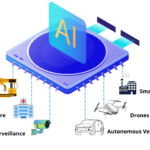Broadening the horizon of telecommunication and technology, 5G the fifth generation of mobile seeks to provide seamless coverage, high data rate, low latency, and a highly reliable communications system. It is a new global wireless standard after 1G, 2G, 3G, and 4G networks. 5G enables a new kind of network that is designed to connect virtually everyone and everything together including machines, objects, and devices. Faster connectivity speeds, ultra-low latency and greater bandwidth is advancing societies, transforming industries, and dramatically enhancing day-to-day experiences.
What makes 5G different?
5G is designed to not only deliver faster, better mobile broadband services compared to 4G LTE, but can also expand into new service areas such as mission-critical communications and connecting the massive IoT. This is enabled by many new 5G NR air interface design techniques, such as a new self-contained TDD subframe design.
The coming of the age 5G technology will provide hassle free coverage in remote areas across the country that will help in boosting energy efficiency, spectrum and network efficiency. 5G will also usher in the era of technology advances in the country such as Virtual Reality (VR), Augmented Reality (AR) and more. These technologies will have an end-to-end effect on multiple sectors – healthcare, agriculture, education, disaster management and others.
What is 5G capable of?
5G will do much more than significantly improve your network connection. It provides new opportunities, enabling us to deliver groundbreaking solutions that reach across society. billions of connected devices gathering and sharing information in real time to reduce road accidents; or life-saving applications that can take flight thanks to lag-free guaranteed connections; or production lines so predictive they can prevent interruptions well before they occur.
The consumer segment is the dominant revenue source for communication service providers (CSPs). 5G is driving new monetization opportunities across consumer areas such as:
- Mobile gaming
- Fixed wireless access
- New immersive user experiences.
5G introduces innovation possibilities which go beyond today’s enterprise limitations, enabling new ways to work, think, and solve traditional business challenges.
There are some very important common characteristics that emerge when looking at the value of 5G for business transformation, for example:
- Run any process remotely, regardless of how critical it is
- Real-time control of every business process
- Automate your operations
- Use compute resources where it makes sense, run applications on the edge where relevant
- Inherent higher security level without sacrificing overall performance
What are the Pros & Cons of 5G Technology?
High speeds– 5G works faster on mobile phones and other devices when compared to 4G and 4G LTE. It allows users to download movies, videos, and music in seconds as opposed to minutes.
Low latency – 5G has low latency when compared to 4G that will support new applications such as AI, IoT, and virtual reality efficiently.
Less tower congestion – 4G cellular networks often get congested which will result in various problems while accessing important data. On the other hand, 5G networks allow users to avoid them due to better speed and more bandwidth.
Cons –
Limited global coverage- Only cities can benefit a lot from 5G network and remote areas may not get the coverage for some years. Moreover, the expenses for setting tower stations are high when compared to other networks.
Decreased broadcast distance – Although 5G works fast at high speed, it won’t travel as far when compared to 4G. Moreover, tall buildings and trees may block the frequency of the 5G network that will result in various problems.
Weakened device batteries – Phones that use a 5G connection will result in a huge battery drain that reduces the lifespan to a large extent.
The sustainable expansion network will help to create innovative network technologies that enable service providers to introduce new services while reducing their carbon emission footprint. 5G services are also expected to play a major role to achieve the economic goal of making India a $5-trillion economy by 2024-25.
Prof. Dr. Milind Pande
Pro-Vice Chancellor
MIT- World Peace University, Pune, Bharat







